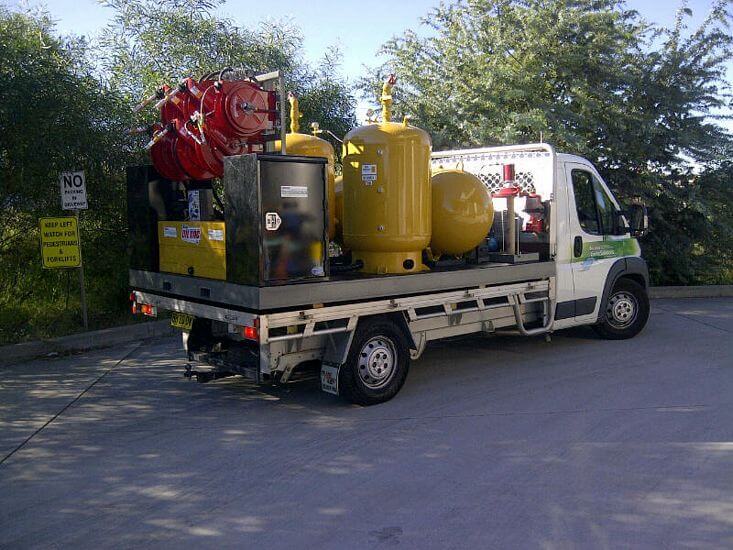In your mind, picture a traditional fuel/lube truck — the kind that’s been common for jobsite fuel and oil delivery around the U.S. for decades. You may see a large tractor-style truck with a bed dominated by a fuel tank around 1,000 gallons in size, likely rolling on a Class 7- or Class 8-sized chassis and driven by a man or woman with the required commercial driver’s license (CDL).
That’s long been the norm for fuel and lube trucks servicing machinery on jobsites around the country. Yet, a combination of factors has many contractors and operators looking to smaller trucks — those in Class 5 and Class 6 — to help them care for equipment on the job. In the process, they’re discovering the cost and efficiency benefits to deploying the class of trucks that weren’t frequently seen on jobsites just a few years ago.
Changing industry dynamics
Commercial fuel and lube trucks typically range in size from Class 5 to Class 8; each class covers vehicles with a specific gross weight range starting at 16,001 pounds. Class 5, for example, ranges from 16,001 to 19,500 pounds, while Class 8 includes anything over 33,000 pounds. A CDL is required to operate a commercial vehicle above 26,000 pounds in weight, making it a necessity to lawfully operate a Class 7 or Class 8 commercial truck.
But despite growing demand for all types of commercial transportation that requires a CDL — namely over-the-road trucking — the number of licensed commercial drivers in the U.S. has not increased. The U.S. Bureau of Labor Statistics expects demand for heavy truck and tractor-trailer drivers to increase on pace with the rest of the nation’s economy, though American Trucking Associations (ATA) leaders have forecast qualified driver shortages of up to 50,000 in the last two years. Despite that demand boost, a similar increase hasn’t happened in licensed commercial drivers. In short, for work requiring a CDL, the demand is growing but the qualified labor pool is not.
“There’s just a shortage of qualified, skilled drivers. It’s as simple as that,” said Sage Oil Vac CEO Aaron Sage.
The CDL shortage is just part of the equation making Class 5 lube trucks the solution for many contractors; traditional Class 7 or Class 8 trucks are large and have high fluid capacities, enabling them to service a lot of equipment. Because of their size, they’re also less fuel efficient when traveling long distances and can be difficult to maneuver on jobsites with uneven terrain and a lot of equipment to service. Add regulatory pressure — which becomes an even bigger issue when traveling across state lines — and operating these larger trucks suddenly can become not just a greater expense and inconvenience but also a hindrance to a company’s future growth.
“If you’re working at a remote location that has a lot of challenging terrain, a smaller truck is going to be more nimble and will perform better in terrain like that than a larger, tandem-axle truck,” Sage said, adding Class 5 Sage Oil Vac lube trucks are built on Ford F550 and Dodge Ram 5500 truck chassis, enabling them to better navigate more varied jobsite terrain than heavier dual-axle tractor-based trucks.
Filling a growing niche
Things like the decline in drivers with CDLs and the efficiency of smaller trucks have made Class 5 machines a more viable option than in the past for many contractors, for both operational and managerial reasons. On top of the benefits of the smaller trucks — like those integrating a Sage Oil Vac 55AB-6101 lube truck body — Class 5 trucks enable mobile equipment service providers to do their job without requiring operators have commercial driver’s licenses. This opens the door to more hiring opportunities for company owners and managers, and more employment opportunities for operators. In this way, Sage Oil Vac Class 5 lube trucks are helping fill a growing niche in the service truck sector.
“We are always honing the design of Class 5 lube truck bodies and putting them with trucks that don’t require a CDL to operate commercially. Many in the industry are talking about moving to smaller trucks for many reasons, and we are working hard to add value to their operations by offering equipment that can make them more efficient,” Sage said. “We want our customers to look at their equipment and determine which system will work best for them. In some cases, multiple Class 5 trucks will be more cost-effective and efficient than one Class 8 truck. It’s sometimes hard to get people to make a change like that, but I think when you put pencil to paper, these types of changes will pay for themselves in a matter of months.”
Learn more about Sage Oil Vac Class 5 lube truck bodies.



